A couple of things to know about the Mahindra Mojo
[i] What is the Price of the Mahindra Mojo?
A: 1.75 Lakh Ex-Showroom Pune. That means the final on road price will be around 2 lakhs.

[ii] When will the Mahindra Mojo be on sale in the showrooms?
A: No dates have been fixed yet. But according to the Mahindra officials it could be probably by late this year or early next year.
[iii] In which cities will the Mahindra Mojo be on sale?
Quality of components used on the Mojo (the bike displayed at the launch) was good
Tyres from Pirelli, USD front suspension from Piaoli Italy..
A: Again Mahindra has yet to finalize the distribution structure for the Mojo (according to what was told in the launch). It probably means that the Mojo would be on sale only in select metros.
Makes sense too since to develop the infrastructure to service such a technically advanced bike will need some time and effort from Mahindra.
[iv] How much of an Indian content will be on the Mahindra Mojo?
According to the Mahindra officials at the launch, the Indian content on the bike will be very less. The parts will be mostly imported and assembled in Mahindra’s Pithampur plant near Indore, M.P.
This means that the bike will be assembled and sold like the Kawasaki Ninja in India. No wonder the price tag is high.
[v] The Mahindra Mojo will be the "Fastest Indian" bike according to Mahindra.
But Mahindra officials did not give a kmph figure with the claim. According to me, with all the imported content on the bike the Mojo will be pitted against the Kawasaki Ninja for this title and not the Pulsar 220 DTS-i.
[vi] The model displayed at the launch was a protoype.
Yes, it was only a prototype and not a working model. But inspite of that, the quality of the parts on the bike was quite decent.
Mahindra Mojo- Features
[Note: The feature list has been complied by whatever was posted on Mahindra Website on 29'th of night and also what was observed on the bike at the launch]
The features has been explained in as simple language as possible, along with the benefits of the feature; for someone who is not that familiar with motorcycle technology and terminology.
1. 300 cc, Single Cylinder, Liquid Cooled Engine

Prior to the launch, rumors were flying thick and fast that the new Mahindra bike will have a twin cylinder engine. A screenshot of the teaser video has indeed shown two exhausts, which raised the hopes of a twin cylinder engine. The bike has two exhausts, but sadly and surprisingly the engine has just a single cylinder.
Benefit: The single cylinder engine should ensure a healthy torque if not high on power like a crazy revving multi cylinder engine. But even then this engine should be capable of revving freely as its stroke seems to be smaller than its bore.
2. Dual Exhausts:

The mojo is the first Indian bike with twin exhausts. Even the twin cylinder Ninja 250R comes with a single exhaust (where two exhausts merge into a single one).
Benefit: This should be purely to give a multi cylinder look to the bike. Its vanity according to me. Even in line 4 cylinder 1000 cc engines come with a single end can these days.
3. 4 Valve Engine with DOHC (Double OverHead Camshafts)
Like the other 4 valve engine bikes in India, viz. the Ninja 250R, YZF R15 and the Pulsar 135LS, the Mojo’s single cylinder head will come with 4 valves.
Benefit: The engine will be relaxed and perform better at higher engine speeds.
The Mojo will be the second bike after the Ninja 250R to feature DOHC (discounting the imports of course).
Benefit: Although not obviously felt, the DOHC arrangement is the preferred one over the simpler SOHC (Single Over Head Cam Shaft) that most of over Indian bikes come with.
4. "Ducati Energia" Electronic Fuel Injection
The Mojo’s engine also features a Fuel Injection system. The marketing name of the Fuel injection system suggests some Italian/Ducati connection. Other bikes with Fuel injection system in India are the Ninja 250R, Karizma ZMR and the YZF R15.
The Fuel Injection system is an advanced system with a lot of electronics, including sensors involved. Unlike a carburettor which is a simple mechanical system, a fuel injected sytem delivers accurate amount of the Air + Fuel mixture to the engine. Which improves the drivability and helps in reducing pollution.
Benefit: After having ridden a Fuel Injected bike (Pulsar 220 DTS-Fi) for 3 years now, I can say that the most obvious advantange of this sytem is during starting. I have never had a problem while starting the bike in any condition and never even had any problem even during idling.
But the fuel injection system does cost a lot. For example after the FI system was replaced with a carburetor on the Pulsar 220, the price dropped by nearly Rs. 15,000..!!
5. Inverted shock absorbers / Upside down shock absorbers
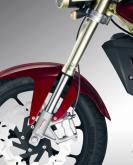
Now this is a feature which has so far only appeared on imported bikes. Not even the Ninja 250R comes with this kind of front suspension. The difference over a normal/conventional front suspension system is that the front forks appears to have been inverted. i.e the fatter outer fork is at the top and the slimmer inner fork at the bottom.
The front suspension on the Mojo is of "Piaoli" make, which is an Italian brand.
Benefit: The theoretical benefit of such a system is that it reduces the un sprung weight (the weight that is not supported by the springs of the suspension, which includes the wheels, tyres and the lower fork of the front suspension). The benefit of having a lower un sprung weight is like wearing lighter shoes. It is supposed to benefit the handling of the bike.
But according to me, it also enhances the looks of the bike giving it a beefy look.
6. Monoshock Rear Suspensions

Examples of other Indian bikes with monoshock rear suspension. The YZF R15, FZ-16/S/Fazer, CB Unicorn and CB Unicorn Dazzler.
Monoshock rear suspension help in centralizing the mass of the bike and hence aids in better handling. Also since the travel of the spring is lesser over a conventional twin spring suspension, the damping fluid in such a suspension doesn’t foam that much under heavy action like on a conventional suspension.
Benefit: Better handling and comfort
7. 320 mm petal shaped front disc brake

At 320 mm, these are the largest front disc brakes on any Indian bike. Petal shaped disc brakes were first incorporated by Kawasaki, later other manufacturers also started to adopt them. TVS does it on the Apache RTR bikes.
Benefit: Apart from looking cool, these brakes are supposed to dissipate heat generated while braking. Which improves braking by lessening brake fade. These brakes are also supposed to be self cleaning (well I am not too sure how..).
8. Double Barrelled Exoframe / Exposed frame running along the sides of the tank
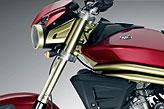
Actually the frame / chassis of the Mojo is a conventional single downtube with engine as a stressed member. The exoframe in a way mimics a perimeter / beam frame and the twin/double tubes also give it a trellis frame like appearance.
Benefit: Apart from improving the aesthetics of the bike, such a frame should also help in improving the handling of the bike.
9. India’s widest rear tubeless radial tyre
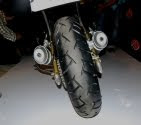
At 140 mm, the widest rear tyre on an Indian bike was that of the Yamaha FZ. But the Mojo now comes with a 150 mm rear tyre which is also of the radial tubeless variety. Plus the tyres are of Pirelli make..!!
Benefit: Unlike the FZ which has a flat shape, the one on the Mojo is rounded, like the ones found on Super Sport bikes. This should improve fuel efficiency apart from hugging the road during cornering. Fat tyres also look good from the back.
Radials help the tyre maintain its shape also makes the tyre lighter. Tubeless tech. makes the tyres safe as there is no sudden loss of tyre pressure even during a puncture.
10. Twin Headlamps with pilot LED’s

The Mojo comes with two retro styled headlamps. The pilot lamps on top of the headlamps are fitted with LEDs, which is another first on an Indian bike.
Benefit: LED’s are the in fashion lighting devices these days. Apart from looking retro with the twin headlamps the LED’s lend a touch of modernity.
11. Digital display

The Mojo comes with a LCD with a Blue Backlit color. It displays speed, fuel gauge readings, rpm, time etc. In fact, it even tells you when to shift gears.
Benefit: Accurate and easy to read display, plus it also looks cool.
12. LED tail lights
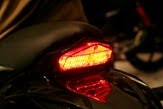
The Tail lights of the Mojo are fitted with LED’s in place of a conventional filament bulb.
Benefit: Apart from appearing attractive, LED’s consume comparatively lesser power and are less prone to failure than incandescent bulbs.
13. Mirror mounted indicators

This is another first in India feature. Mostly premium cars have turn indicators on their rear view mirrors (RVMs). There are also a couple of foreign bikes which have a similar arrangement.
Benefit: Mostly an aesthetic feature, according to me.
14. Back lit switches
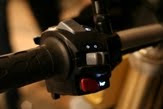
These are like the ones which are seen on our Pulsars.
Benefit: For a rider new to the bike, it is a useful feature in the dark. But apart from that, it just imparts a cool, premium look to the bike.
15. LED on the rear brake caliper

Correction: This LED is actually not a Rear Brake Light indicator as earlier stated. This LED actually comes on along with the other lights on the bike and is just an aesthetic feature.
By the way, the Speed sensor on the Mojo is actually mounted on the rear wheel where this LED is mounted.
Benefits: Extra lighting always helps in providing better visibility. Also gives the bike a pimped up/customized look.
Mahindra Mojo Specifications
[Note: The specs has been taken from what was posted on the Mahindra website on 29'th Sep, 2010]
Engine Type:
Single Cylinder, Liquid Cooled, 4 Valves, DOHC
Displacement: 292 cc
Bore x Stroke: 78 mm x 61.2 mm
Compression Ratio: 11 : 1
Maximum Power: 26.3 Ps @ 8500 rpm
Maximum Torque: 24 Nm @ 7000 rpm
Transmission / Gear Box: Constant Mesh, 6 speed
Dimensions:
Overall length x width x height (mm): 2100 x 830 x 1270
Seat Height (mm): 820
Wheelbase, (mm): 1450
Minimum ground clearance (mm): 150
Kerb Weight (Kgs): 160
Fuel Tank Capacity in liters: 15.5
Chassis:
Frame Type: Twin Tube Exposed frame in Steel; Diamond Frame
Wheel Type: Alloy Wheel
Tyres: Tubeless 100/80 – 17” (Front) 150/60 -17” (Rear)- radial
Brakes: Disc 320 mm (Front); Disc 220 mm (Rear);
Suspension:
Inverted fork Telescopic hydraulic-damped (Front);
120 mm stroke Horizontally mounted Mono Shox (Rear)
Electricals:
Battery: 12V, 9 AH; Maintenance Free
Head Lamp: 35W / 35W X 2; Halogen Bulb (Multi Reflector Type)
Pilot Lamps: 4 LED’s each side, above twin beam Head Lights
Tail Lamp: LED (with 12 LED’s)
The quality of components used on the Mojo was really impressive.
After all with all the parts from foreign vendor like Pirelli Tyres, Piaoli Suspension, the finish on most of the bike was quite good.
A few small bits like the quality of the switches, brake and clutch levers etc. could improve though. But Considering this was just a prototype, I hope that these parts gets the quality treatment as well when the production begins.
Click at the thumbnails for a larger image
[Note: Photo credits to MG_Biker1806 from xBhp.com and Myself]
 |  |  |
 |  |  |
 |  |  |
 |  |  |
 |  |  |
Related Posts
- Mahindra Mojo & Stallio launch in Mumbai [Photos]
- Mahindra new motorcycles, Mojo 300 cc & Stallio 110 cc
- Mahindra Motorcyle to be launched soon..!! Teaser Video
- Auto Expo 2010 Coverage: Mahindra 2 Wheelers
Disclaimer:
This is to remind that the Views or Opinions in the blog are entirely mine unless explicitly stated. The Views and Opinions published in this blog should in no way be related to any other person or organization associated -- directly or indirectly -- with me.












12 Comments:
Well compared to a SOHC engine, DOHC engine have crisper throttle response. This does come at a price of the fuel economy (if all the other factors remains same between the two types of engines). A DOHC configuration also helps you to get the max bang out of the Engine unit as now there are two cam shafts instead of one, so, each cam shaft is concentrating only on two cams at a time.
For the USD forks on the Mojo, I feel that the rake angle of the bike is a bit too much than required in it's class and therefore the travel of the lower cylinder is a bit too much.
@Sajal,
even I feel the same way about the rake angle of the front forks on the Mojo
Any how bike is really awesome compared to other Indian bikes
It's a gay bike :-(
The worst welding finishes.Just watch the joints in the pics.
@above,
the quality of parts used on the bike was in fact quite decent.
NiNjA:WE R READY FOR THE BATTLE WE WILL SETTLE IT ON INDIAN ROADS!!!!
TEAM NiNjA: FOR NiNjA BOYS IF ANYONE ENCOUNTER WIT A MOJO IN STREETS SHOW HIM WHAT WE R MADE OFF & LET HIM SUFFER FOR HIS FAILURE
mr.austin powers mahindra has stolen your "MOJO"!
somebody please explain why two exhausts for a single cylinder engine..reminds me of the dudhwalas yezdi!
headlamp assembly reminds me of WALL-E
-nikhilwdev@gmail.com
Any how bike is really awesome compared to other Indian bikes
@:Now this is a feature which has so far only appeared on imported bikes.
i remember dat once d limited edition bike Kinetic Comet too has inverted shocks...so is dat even a imported bike so far....
can we easily find a spare parts easily?eq;those tyres and forks?otherwise it is a bike customized rarely.the two headlamps look like a monkey eyes,but honestly i like it.
but for a new entrant the pricing should hav been much more competitive
Post a Comment
Your Comments are valuable as they keep the conversation alive..
But Please Comment Responsibly (for them to be published)